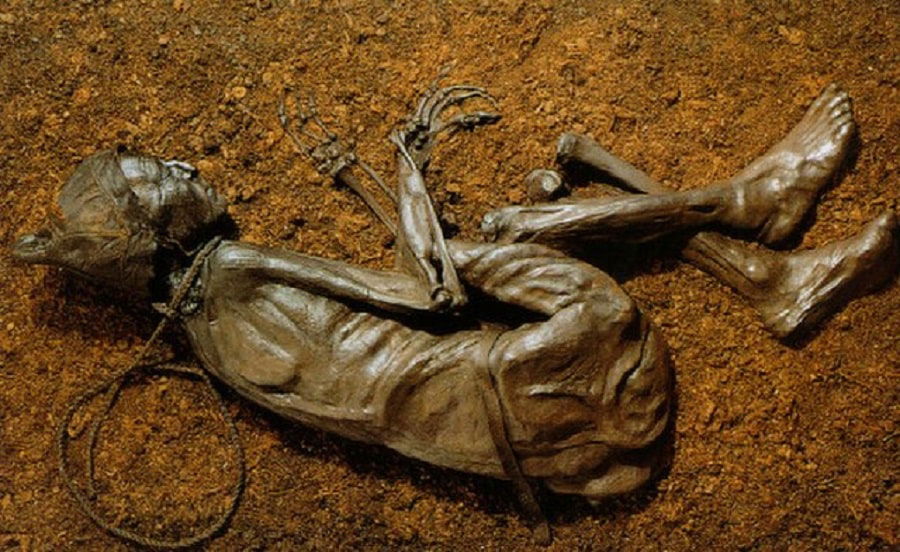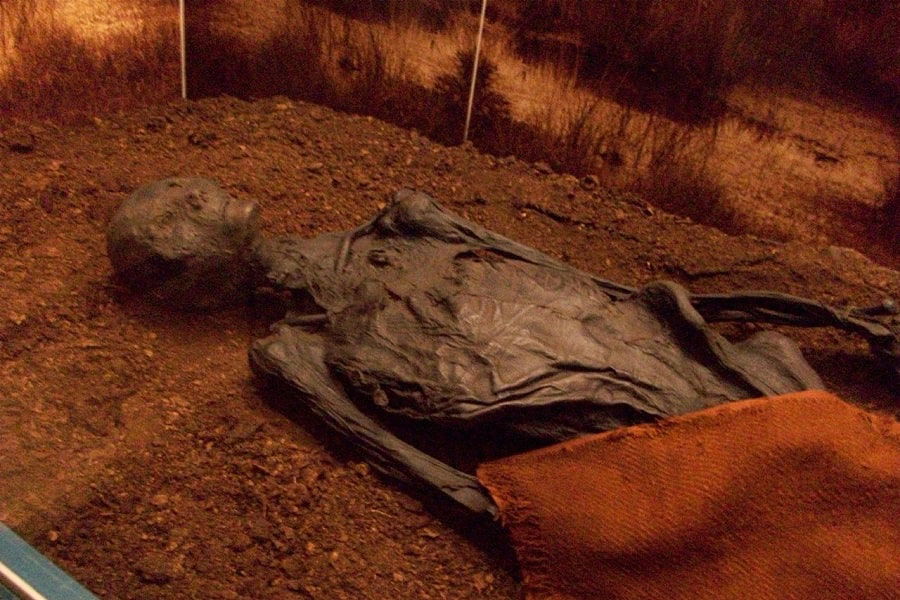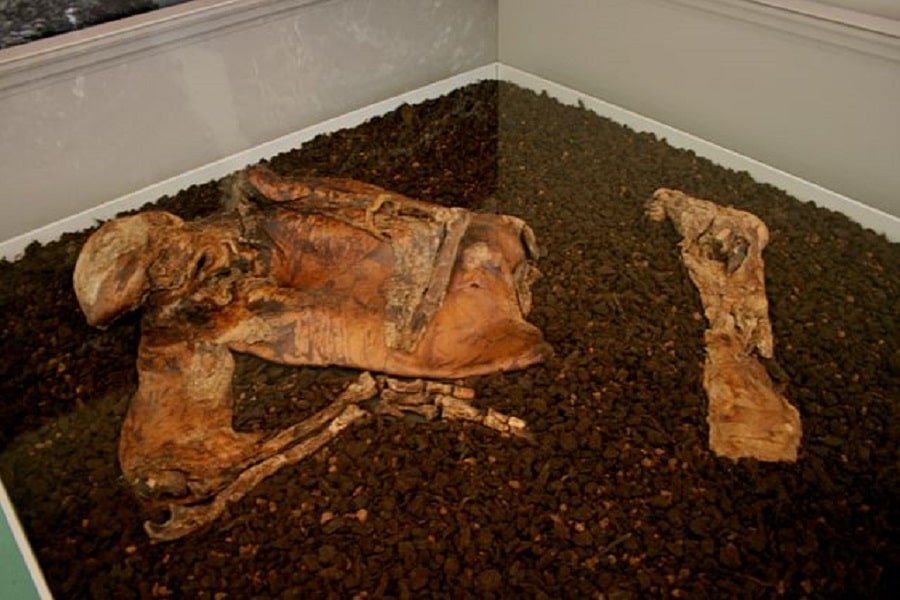A bog body is a naturally mummified corpse found in peat bogs. Found throughout western and northern Europe, these remains are so well preserved that the people who discovered them mistook them for recent deaths. There are over a hundred such bodies and they are found scattered throughout Scandinavia, the Netherlands, Germany, Poland, the United Kingdom, and Ireland. Also called the bog people, the common factor is that they were found in peat bogs in perfectly preserved states. Many of them are also believed to have died violent deaths.
Table of Contents
What is a Bog Body?

A bog body is a perfectly preserved body found in peat bogs in northern and western Europe. The time range for this kind of bog mummy can be anywhere between 10,000 years ago and World War II. These ancient human remains have been found time and again by peat diggers, with their skin, hair, and internal organs completely intact.
In fact, a bog body found in 1950, near Tollund in Denmark, looks just like you or me. Popularly known as Tollund Man, this man died 2500 years ago. But when his discoverers found him, they thought they had uncovered a recent murder. He had no clothes on other than a belt and a strange skin cap on his head. There was a leather thong wrapped around his throat, believed to be the cause of his death.
Tollund Man is the most well-preserved of his kind. He is said to cast quite a spell on onlookers because of the peaceful and benign expression on his face despite his violent death. But Tollund Man is far from the only one. Modern archaeologists and anthropologists suspect that these men, women, and in some cases children may have been sacrificed.
Bog bodies have also been found in Florida in the United States. These skeletons were buried sometime between 8000 and 5000 years ago. The skin and internal organs of these bog people have not survived, since the peat in Florida is much wetter than that found in European bogs.
Seamus Heaney, the Irish poet, has written a number of poems about bog bodies. It is quite evident what a morbidly fascinating subject this is. It captures the imagination because of the number of questions it raises.
Why Are Bog Bodies So Well Preserved?

The one question that is often asked of these Iron Age bog bodies is how they are so well preserved. Most bog bodies date from even before the first ancient civilizations. Long before the people of ancient Egypt started mummifying corpses for the Egyptian afterlife, these naturally mummified corpses had existed.
The oldest bog body discovered so far is the skeleton of Koelbjerg Man from Denmark. This body has been dated back to 8000 BCE, during the Mesolithic period. Cashel Man, from about 2000 BCE in the Bronze Age, is one of the older specimens. Most of these bog bodies are from the Iron Age, roughly between 500 BCE and 100 CE. The most recent bog bodies, on the other hand, are Russian soldiers from World War II preserved in Polish bogs.
So how are these bodies preserved so perfectly? What accident caused these bog skeletons to be mummified in this manner? This kind of preservation happened naturally. It was not a result of human mummification rituals. It is caused by the biochemical and physical composition of the bogs. The best-preserved bodies were found in raised bogs. The poor drainage there makes the ground waterlogged and causes all the plants to decay. Layers of sphagnum moss grow over thousands of years and a contained dome is formed, fed by rainwater. The cold temperatures in North Europe also help with conservation.
READ MORE: Who Invented Water? History of the Water Molecule

These bogs have a high degree of acidity and the body decomposes very slowly. The skin, nails, and hair also get tanned. This is why most bog bodies have red hair and copperish skin. That was not their natural coloring. It is an effect of the chemicals.
Salty air blowing in from the North Sea in the Danish bog where Haraldskær Woman was found helped in the formation of peat. As peat grows and new peat replaces old peat, the older material rots and releases humic acid. This has a similar ph level to vinegar. Thus, the phenomenon is not unlike the pickling of fruits and vegetables. Some of the other bog bodies have had their internal organs so well preserved that scientists have been able to verify what they ate for their last meals.
The sphagnum moss also causes the calcium to leach out of the bones. Thus, the preserved bodies end up looking like deflated rubber dolls. Aerobic organisms cannot grow and live in the bogs so this helps to slow down the decomposition of natural materials like hair, skin, and fabric. Thus, we know that the corpses were not buried while wearing clothes. They have been discovered naked because that is how they were buried.
How Many Bog Bodies Have Been Found?

A German scientist called Alfred Dieck published a catalog of more than 1850 bodies that he had come across between the years 1939 to 1986. Later scholarship has shown that Dieck’s work is completely unreliable. The number of bog bodies that have been discovered is about 122. The first records of these bodies were found in the 17th century and they still regularly turn up. So we can’t put a definitive number to it. Several of them are very well known in archaeological circles.
The most famous bog body is the well-preserved body of the Tollund Man with his peaceful expression. Lindow Man, found near Manchester, England, is one of the other seriously studied bodies. A young man in his 20s, he had a beard and a mustache, unlike all the other bog bodies. He died sometime between 100 BCE and 100 CE. The death of Lindow Man is more brutal than any of the others. Evidence shows he was struck on the head, had his throat cut, his neck broken with a rope, and was thrown face down in the bog.
Grauballe Man, found in Denmark, was excavated carefully by archaeologists after peat cutters accidentally struck his head with a shovel. He has been widely X-rayed and studied. His throat was cut. But before that, Grauballe Man ate a soup that had hallucinogenic fungi in it. Perhaps he needed to be put into a trance-like state for the ritual to be carried out. Or perhaps he was being drugged and murdered.

Gallagh Man from Ireland was discovered lying on his left side covered in a skin cape. Anchored to the peat with two long wooden stakes, he also had willow rods wrapped around his throat. These had been used to throttle him. Children like Yde girl and Windeby girl, both below 16 years of age, have also been discovered. The hair on one side of their heads was cut off. The latter was found feet away from the corpse of a man and scholars theorize they could have been punished for an affair.
One of the most recent of these bog bodies is Meenybradden Woman. She was wearing a woolen cloak of the late 16th century CE style. She was probably in her late 20s or early 30s at the time of her death. The fact that she lies in the bog instead of a consecrated grave seems to imply that her death was the result of suicide or murder.
These are only a few examples of the preserved remains discovered so far. Others, most of them Iron Age, are Oldcroghan Man, Weerdinge Men, Osterby Man, Haraldskjaer Woman, Clonycavan Man, and Amcotts Moor Woman.
What Do Bog Bodies Tell Us About the Iron Age?

Many of the bog body finds have shown evidence of dying violent and brutal deaths. Were they criminals being punished for their wrongs? Were they the victims of a ritual sacrifice? Were they the outcasts who were considered unacceptable by the society they lived in? And why were they the ones left buried in the bogs? What were the people of the Iron Age attempting to do?
The most common consensus is that these deaths were a form of human sacrifice. The age in which these people lived was a difficult one. Natural disasters, famine, and scarcity of food led to fear of the gods. And sacrifice was believed to appease the gods in many ancient cultures. The death of one would lead to the benefit of many. Archaeologist Peter Vilhelm Glob, in his book The Bog People, stated that these people were sacrificed to the Earth Mother for a good harvest.
READ MORE: Pagan Gods from Across the Ancient World
Nearly all of these people were deliberately killed. They were the victims of stabbing, strangling, hanging, beheading, and being clobbered on the head. They were buried naked with the rope still around their necks. A grim concept, indeed. Historians and archaeologists are still asking the question of why someone would be killed so brutally.
Most bog bodies from ancient Ireland were found along the borders of the ancient kingdoms. Some historians believe this lends credence to the idea of human sacrifice. The kings were killing people to ask for protection over their kingdoms. Perhaps they even were criminals. After all, if the death of a ‘bad’ person can save hundreds, why not take it?
Why were these bodies found in bogs? Well, bogs were seen as gateways to the otherworld in those days. The will of the wisps that we now know are the result of gasses released by the bogs and were thought to be fairies. These people, whether they were criminals or outcasts or sacrifices, could not be buried with ordinary people. Thus, they were deposited in the bogs, these liminal spaces that were connected to another world. And because of this sheer chance, they have survived to tell us their stories.